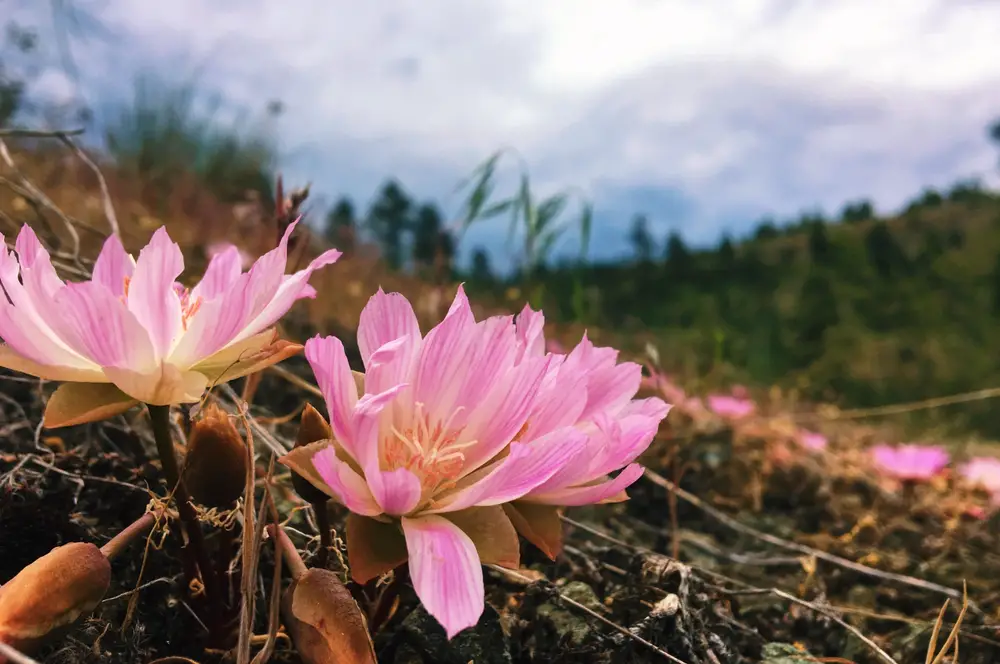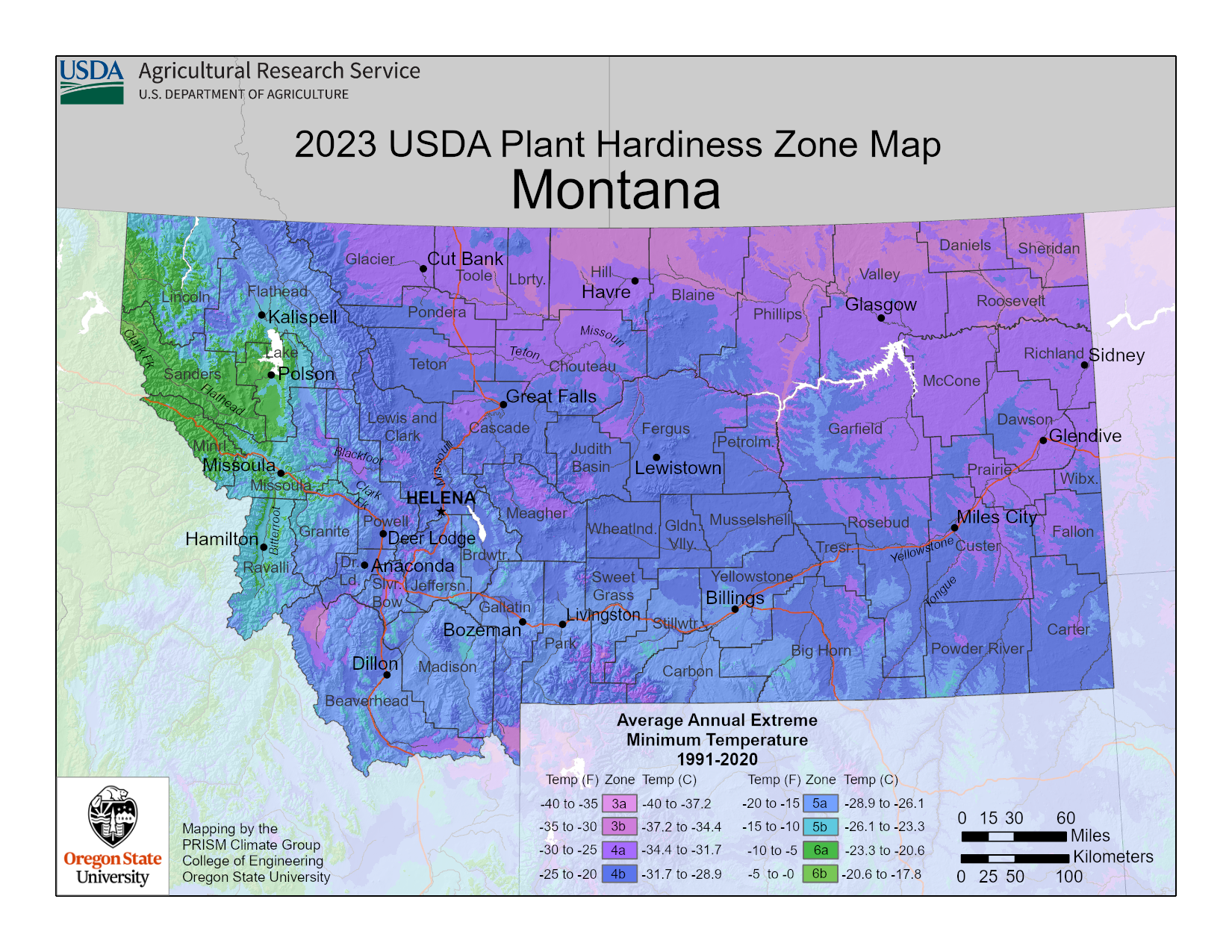Montana Plant Hardiness Zones
| USDA Hardiness Zone | Average Minimum Extreme Winter Temperature Range Fahrenheit (°F) Celsius (°C) | Average Last Frost Date Range In Spring (Beginning Of The Growing Season) | Average First Frost Date Range In Autumn (End Of The Growing Season) |
|---|---|---|---|
| 3a | -40°F to -35°F -40°C to -37.2°C | Mid to Late May | Early to mid-September |
| 3b | -35°F to -30°F -37.2°C to -34.4°C | Mid to late May | Early to mid-September |
| 4a | -30°F to -25°F -34.4°C to -31.7°C | Mid to late May | Mid to late September |
| 4b | -25°F to -20°F-31.7°C to -28.9°C | Mid to late May | Mid to late September |
| 5a | -20°F to -15°F-28.9°C to -26.1°C | Early to mid-May | Late September to early October |
| 5b | -15°F to -10°F -26.1°C to – 23.3°C | Early to mid-May | Late September to Early October |
| 6a | -10°F to -5°F -23.3°C to 20.6°C | Late April to early May | Early to mid-October |
| 6b | -5°F to 0°F -20.6°C to 17.8°C | Late April to early May | Early to mid-October |
Montana Growing Conditions

Credit to Wikipedia
General Climate
Montana has a wide range of growing zones from 3a to 6b. It experiences many types of weather, from cold, rigid winters to high winds and extreme heat.
The continental divide splits Montana and creates eastern and western regions. In Montana’s Glacier National Park there is a rare triple divide. Here the water drains into three separate bodies of water: the Pacific Ocean on the west, the Gulf of Mexico on the southeast, and the Hudson Bay on the northeast.
The eastern portion of the state is a semi-arid or steppe climate. This climate is dry with minimal annual precipitation. This area of the state is dominated by badlands and prairie terrain.
The west is a humid continental climate, which has large temperature fluctuations within the seasons. The humid summers and cold winters are less extreme on the Pacific coast which sees cooler summers and milder winters. This area is mountainous with deep valleys.
Higher elevations of the state are continental subarctic regions. Here, the year is dominated by extremely cold, long winter seasons with little precipitation and very low humidity.
A small area in the northwest has a warm summer continental climate. This type of climate has large seasonal temperature fluctuations with warm, humid summers with cold winters.
These different regions all have specific growing conditions. For gardening success in Montana is it important to understand which climate region you are in and what plants best grow there.
Microclimates
USDA plant hardiness zones are an important starting point for your garden, but you’ll also need to consider microclimates.
Microclimates are areas where specific conditions create a climate different from the climate they’re situated in.
Buildings, fences, paved areas, or short hills and valleys can create these microclimates.
They can be as small as a space in your backyard or as large as a city.
In other words, learn about your local conditions from local experts to see if your garden falls into a microclimate.
Extreme Weather
Extreme Cold
Overall, the state of Montana has a short growing season. The areas of higher elevation have a subarctic climate region with predominantly colder weather.
Extreme cold is common in Montana and can make growing in this state challenging. Choosing plants that can tolerate the cold can be a great way to add color to the garden.
Peonies are a wonderful perennial flower that do well in cold weather climates. When planted in groupings of 3 or more, they make a showy impact in the garden space.
Chinook Winds
Chinook winds are warm winds that move from higher elevations down to lower terrain. This air flow moves quickly causing a dramatic increase in temperature over a short period of time. Temperatures can rise 25 to 50 degrees and wind speeds can reach up to 80 to 100 mph (128 to 160 kph).
Typically these winds are created by large storms moving across the Pacific Ocean, but they can also occur even if the sky is clear and no storms are present.
Chinook winds are common in Montana and occur most frequently in autumn through to early spring.
Although extreme winds may be hard to anticipate, one way to protect your garden is to create hedgerows. These borders help to buffer and dissipate wind. Using trees, shrubs, and perennials with strong root systems creates a barrier against the wind and directs the airflow around the space.
Growing Season
Overall, Montana has a short growing season with an average of 116 frost-free days. Though, the number of growing days varies heavily depending on which growing climate you live in.
On average, the last frost is from the end of April to early May and the first frost happens from September to October.
Season extending tools such as high tunnels, row cover, cold frames, and mulch are great ways to increase the growing season. Although with Montana’s cold climate, a heated greenhouse is your best bet. These tools help protect crops against bad weather and extend the growing season by weeks to months.
Montana Gardening Tips

Understanding Climate Zones
With so many different growing regions within Montana, it is important to understand the differences in these climates to have the best chance of success for growing.
With climates ranging from subarctic to warm summer continental, it can be a little overwhelming! First, start by referring to the USDA Hardiness Zones Map. Locate where you live and find out the hardiness zone for your area. Next, refer to the Koppen climate map and establish which climate type you live in.
By understanding your zones and regions you can best determine what plants will thrive there. This is a great way to tackle a shorter growing season.
Planting native plants is one of the best ways to have a successful garden when growing in such a diverse region. They are tolerant of weather conditions, draw in the pollinators, and help create a biodiverse, successful and sustainable landscape.
Planting In Alkaline Soil
Another gardening challenge in Montana is the predominantly alkaline soil that is common throughout the state.
Alkaline soils have high concentrates of calcium (Ca), sodium (Na), and magnesium (Mg). This is created by carbonate-rich rocks that break down over time.
These minerals create high pH levels in the soil that hinder plant growth and make soil less soluble. This makes it harder for plants to absorb the nutrients they require to survive. Characteristics of alkaline soil include:
- Plants that grow curled
- Plants that have yellowing leaves
- Plants that have unusually purple stems
Most plants require slightly acidic or neutral pH to grow well. However, there are some plants that do tolerate more alkaline soil, such as clematis and apricots.
The best way to reduce the alkaline soil is to amend your soil with organic matter and use fertilizers with more acidic properties. Coffee grounds have an acid base and are a great amendment for alkaline soils.
Other organic matter to help build the soil includes:
- Mulch
- Peat moss
- Coconut coir
- Compost
Consult With Local Professionals
Consulting with local gardening professionals allows you to benefit from their experience with your area’s conditions, the plants that do well there, and overall best practices.
Montana Plant Suggestions

Trees
- Douglas Hawthorn (Crataegus douglasii)
- Rocky Mountain Juniper (Juniperus scopulorum)
- Ponderosa Pine (Pinus ponderosa)
Shrubs
- Trilobe Sumac (Rhus trilobata)
- Basin Big Sagebrush (Artemisia tridentata spp. tridentata)
- Lewis’ Mockorange (Philadelphus lewisii)
Flowers
- Prairie Smoke Geum (Geum triflorum)
- Pearly Everlasting (Anaphalis margaritacea)
- Rocky Mountain Columbine (Aquilegia caerulea)
Vegetables
- Winter Squash (Cucurbita moschata)
- Endive (Cichorium endivia)
- Arugula (Eruca vesicaria subsp. sativa)
Herbs
- Catnip (Nepeta cataria)
- Chicory (Cichorium intybus)
- Dill (Anethum graveolens)
Spices
- Anise (Pimpinella anisum)
- Basil (Ocimum basilicum)
- Caraway (Carum carvi)
Fruits
- Serviceberry (Amelanchier alnifolia)
- Common Chokecherry (Prunus virginiana)
- Silver Buffaloberry (Shepherdia argentea)
Succulents
- Pincushion Cactus (Coryphantha vivipara)
- Prickly Pear Cactus (Opuntia polyacantha)
- Missouri Foxtail Cactus (Coryphantha missouriensis)
Disclaimer
Any of the above can change and is not exhaustive.
Treat anything above like a good starter guide. Then use that as a foundation as you consult with local gardeners, professionals, forecasts, guides, and organizations.

